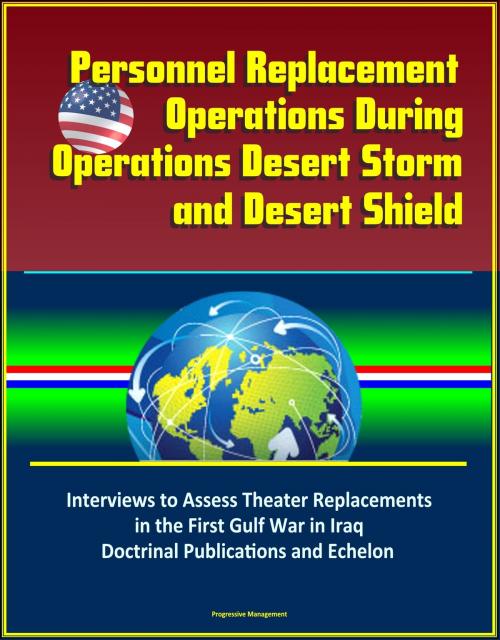Personnel Replacement Operations During Operations Desert Storm and Desert Shield: Interviews to Assess Theater Replacements in the First Gulf War in Iraq, Doctrinal Publications and Echelon
Nonfiction, History, Middle East, Persian Gulf War, Military, United States| Author: | Progressive Management | ISBN: | 9781370616299 |
| Publisher: | Progressive Management | Publication: | January 24, 2017 |
| Imprint: | Smashwords Edition | Language: | English |
| Author: | Progressive Management |
| ISBN: | 9781370616299 |
| Publisher: | Progressive Management |
| Publication: | January 24, 2017 |
| Imprint: | Smashwords Edition |
| Language: | English |
This excellent report has been professionally converted for accurate flowing-text e-book format reproduction. This study uses historical narratives in the forms of interviews conducted after the conclusion of Operations Desert Shield and Desert Storm to assess personnel replacement operations. The primary research question focuses on the adequacy of replacement operations during this period using the personal assessments of individuals involved in theater replacement operations. Adequacy for this research study focuses on two elements. First, it seeks to find specific statements made by the interviewees about issues/concerns with replacement operations with the actual workload from combat operations. Additionally, the study seeks to identify issues/concerns these leaders identify as potentially problematic had the amount of casualties met or exceeded the planning estimates. These challenges were assessed using the doctrine, organization, training, materiel, leadership, personnel, facilities, and policy (DOTMLPF-P) framework to determine which of the categories led to the issue/concern. The intent of this historical analysis is to assess performance of theater replacement operations during Operations Desert Shield and Desert Storm in order to assess what, if any, additional considerations should be made for human resource operations in Unified Land Operations.
The purpose of this study is to critically assess personnel replacement operations during Operations Desert Shield and Desert Storm. During these operations, the Army achieved tactical and operational success. The Army successfully liberated Kuwait from Iraqi forces, and the American people celebrated at the conclusion of what has been deemed the 100 hour war. Despite these successes, the sustainment of forces in Saudi Arabia and Kuwait presented challenges to the military-particularly Human Resources (HR) support. From the challenges of processing mail to conducting Personnel Information Management to managing casualty operations, HR providers overcame equipment and manning shortages. One area of particular importance involves replacement operations and the buildup of forces in preparation for combat operations. In assessing the effectiveness of personnel replacement operations, it is the intent of this research study to assess the current capabilities of the Army's HR system to conduct individual replacement operations in support of Unified Land Operations.
Operations Desert Shield and Desert Storm served as a display of American military power. By most accounts, the operation was an overwhelming success. The United States was able to deploy forces to Saudi Arabia at the request of the Saudi King, and the Americans were able to build an international coalition opposed to the Iraqi occupation of Kuwait. In the end, 31 countries, including the United States, provided forces to expel Saddam Hussein's forces from Kuwait.
This excellent report has been professionally converted for accurate flowing-text e-book format reproduction. This study uses historical narratives in the forms of interviews conducted after the conclusion of Operations Desert Shield and Desert Storm to assess personnel replacement operations. The primary research question focuses on the adequacy of replacement operations during this period using the personal assessments of individuals involved in theater replacement operations. Adequacy for this research study focuses on two elements. First, it seeks to find specific statements made by the interviewees about issues/concerns with replacement operations with the actual workload from combat operations. Additionally, the study seeks to identify issues/concerns these leaders identify as potentially problematic had the amount of casualties met or exceeded the planning estimates. These challenges were assessed using the doctrine, organization, training, materiel, leadership, personnel, facilities, and policy (DOTMLPF-P) framework to determine which of the categories led to the issue/concern. The intent of this historical analysis is to assess performance of theater replacement operations during Operations Desert Shield and Desert Storm in order to assess what, if any, additional considerations should be made for human resource operations in Unified Land Operations.
The purpose of this study is to critically assess personnel replacement operations during Operations Desert Shield and Desert Storm. During these operations, the Army achieved tactical and operational success. The Army successfully liberated Kuwait from Iraqi forces, and the American people celebrated at the conclusion of what has been deemed the 100 hour war. Despite these successes, the sustainment of forces in Saudi Arabia and Kuwait presented challenges to the military-particularly Human Resources (HR) support. From the challenges of processing mail to conducting Personnel Information Management to managing casualty operations, HR providers overcame equipment and manning shortages. One area of particular importance involves replacement operations and the buildup of forces in preparation for combat operations. In assessing the effectiveness of personnel replacement operations, it is the intent of this research study to assess the current capabilities of the Army's HR system to conduct individual replacement operations in support of Unified Land Operations.
Operations Desert Shield and Desert Storm served as a display of American military power. By most accounts, the operation was an overwhelming success. The United States was able to deploy forces to Saudi Arabia at the request of the Saudi King, and the Americans were able to build an international coalition opposed to the Iraqi occupation of Kuwait. In the end, 31 countries, including the United States, provided forces to expel Saddam Hussein's forces from Kuwait.















